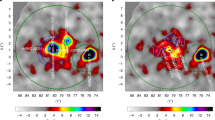Abstract
The X-ray binary system Cygnus X-3 is a source of particular interest. As well as emitting X rays which are modulated with a 4.8-h period, it has been observed in 30–100 MeV γ rays by the SAS II satellite1 and several groups have detected γ rays in the TeV range showing the same 4.8-h period2–5. Additionally there is evidence of a 34.1-day period2,6,7 and of random variations correlated with X-ray emission and radio outbursts8,9. Most recently, Samorski and Stamm10, using the small extensive air shower array at Kiel, have found that the γ-ray spectrum of Cygnus X-3 extends above 2×1015 eV, with an integral flux of (7.4±3.2)×10−14 cm−2 s−1. This result has considerable implications both for our understanding of the source and for the solution of the long-standing problem of the origin of cosmic rays. We now confirm the Kiel observations and present evidence that the γ-ray spectrum of Cygnus X-3 steepens above 1016 eV.
This is a preview of subscription content, access via your institution
Access options
Subscribe to this journal
Receive 51 print issues and online access
$199.00 per year
only $3.90 per issue
Buy this article
- Purchase on Springer Link
- Instant access to full article PDF
Prices may be subject to local taxes which are calculated during checkout
Similar content being viewed by others
References
Lamb, R. C., Fichtel, C. E., Hartman, R. C., Kniffen, D. A. & Thompson, D. J. Astrophys. J. Lett. 212, L63–L66 (1977).
Stepanian, A. A., Fomin, V. P., Neshpor, Yu. I., Vladimirsky, B. M. & Zyskin, Yu. L. in Proceedings of the International Workshop on Very High Energy Gamma Ray Astronomy, Ootacamund, India (eds Ramana Murthy, P. V. & Weekes, T. C.) 43–63 (Tata Institute of Fundamental Research and Smithsonian Institution, 1982).
Danaher, S., Fegan, D. J., Porter, N. A. & Weekes, T. C. Nature 289, 568–569 (1981).
Lamb, R. C., Godfrey, C. P., Wheaton, W. A. & Tümer, T. Nature 296, 543–544 (1982).
Mukanov, D. B., Nesterova, N. M., Stepanian, A. A. & Fomin, V. P. Izv. Krymskoi Astrofiz. Obs. 62, 98–102 (1980).
Molteni, D., Rapisarda, M., Robba, N. R. & Scarsi, L. Astr. Astrophys. 87, 88–91 (1980).
Gibson, A. I. et al. in Proceedings of the International Workshop on Very High Energy Gamma Ray Astronomy, Ootacamund, India (eds Ramana Murthy, P. V. & Weekes, T. C.) 97–117 (Tata Institute of Fundamental Research and Smithsonian Institution, 1982).
Weekes, T. C., Danaher, S., Fegan, D. J. & Porter, N. A. Astr. Astrophys. 104, L4–L6 ( 1981 ).
Fomin, V. P., Neshpor, Yu. I., Stepanian, A. A., Zyskin, Yu. L. & Vladimirsky, B. M. Conference Papers of 17th International Cosmic Ray Conference, Paris Vol. 1, 28–31 (Comissariat à l'Energie Atomique and IUPAP, 1981).
Samorski, M. & Stamm, W. Astrophys. J. Lett. 268, L17–L21 (1983); Conference Papers of 18th International Cosmic Ray Conference, Bangalore 1, 135–138 (Tata Institute of Fundamental Research, Bombay, 1983).
Edge, D. M. et al. J. Phys. A6, 1612–1634 (1973).
van der Klis, M. & Bonnet-Bidaud, J. M. Astr. Astrophys. Lett 95, L5–L7 (1981).
Hearn, D. Nucl. Instrum. Meth. 70, 200–204 (1969).
Parsignault, D. R., Schreier, E., Grindlay, J. & Gursky, H. Astrophys. J. Lett. 209, L73–L75 (1976).
Elsner, R. F. et al. Astrophys. J. 239, 335–344 (1980).
Hillas, A. M. Conference Papers of 14th International Cosmic Ray Conference, München, 9, 3439–3443 (Max Planck Institut für extraterrestriche Physik, Munich, 1975).
Hillas, A. M. Conference Papers of 16th International Cosmic Ray Conference, Kyoto 8, 7–12 (1981).
Morello, C., Navarra, G. & Vernetto, S. Conference papers of 18th International Cosmic Ray Conference, Bangalore 1, 127–130 (Tata Institute of Fundamental Research, Bombay, 1983).
Helmken, H. F. & Weekes, T. C. Astrophys. J. 228, 531–535 (1979).
Hayashida, N. et al. Conference Papers of 17th International Cosmic Ray Conference, Paris 9, 9–12 (Comissariat à l'Energie Atomique and IUPAP, 1981).
Gould, R. J. & Schréder, G. P. Phys. Rev. 155, 1404–1407 (1967).
Stecker, F. W. in Cosmic Gamma Rays, 80 (Mono, Baltimore, 1971).
Lauqué, R., Lequeux, J. & Nguyen-Quang-Rieu Nature phys. Sci. 239, 119–120 (1972).
Vestrand, W. T. & Eichler, D. Astrophys. J. 261, 251–258 (1982).
Author information
Authors and Affiliations
Rights and permissions
About this article
Cite this article
Lloyd-Evans, J., Coy, R., Lambert, A. et al. Observation of γ rays >1015 eV from Cygnus X-3. Nature 305, 784–787 (1983). https://doi.org/10.1038/305784a0
Received:
Accepted:
Issue Date:
DOI: https://doi.org/10.1038/305784a0
This article is cited by
-
Gamma-ray astronomy by the air shower technique: Performance and perspectives
Il Nuovo Cimento C (1996)
-
New astronomies with Extensive Air Showers
Il Nuovo Cimento C (1995)
-
The plasma physics of shock acceleration
Space Science Reviews (1991)
Comments
By submitting a comment you agree to abide by our Terms and Community Guidelines. If you find something abusive or that does not comply with our terms or guidelines please flag it as inappropriate.



